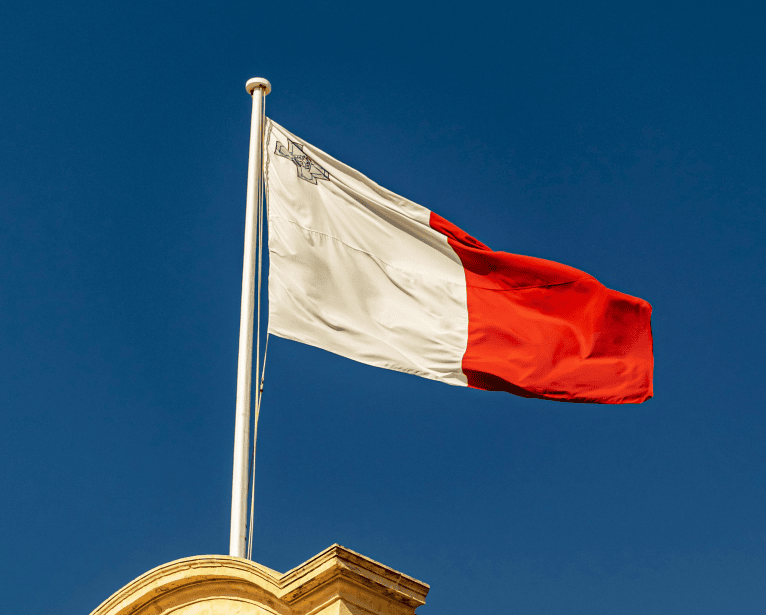Are you on the hunt for your next travel adventure? Perhaps you’ve heard about a place called Malta, and want to learn more about it? If so, you’re in the right spot! This guide to Malta, written by a local, has all the insider knowledge you need. Where is Malta? What’s its story? What’s the climate like? What languages are spoken there? What’s it famous for? Find out all the answers to your questions – and more – below!
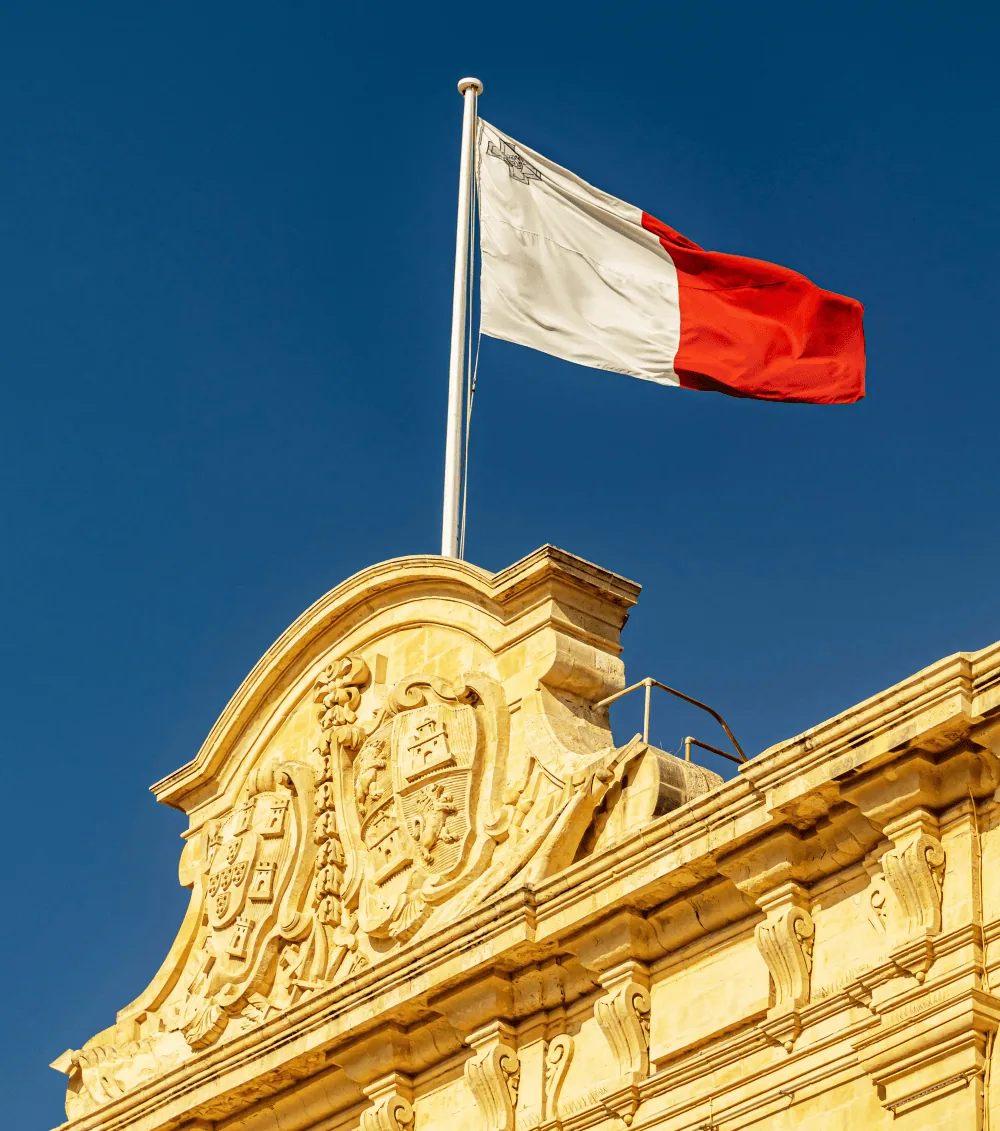
Picture this: a sun-kissed Mediterranean island archipelago, with a culture as diverse as its history. Welcome to the country of Malta! Its history is a tale older than recorded time, with mysterious beginnings in the prehistoric era. Important chapters have been written by the Phoenicians, Romans, Arabs, Normans, and the British. Today, Malta is an independent country at the southern European border, a modern representative democracy, and a member of the European Union.
“Where Is Malta?”
So, where is Malta? As every local can attest to, the first question we are typically asked while abroad is our home country’s geography and location. So, here goes! Malta is located in the heart of the Mediterranean Sea, 93 kilometers south of Sicily and 288 kilometers north of the African coast.
This central location has made Malta a crossroads of civilizations for centuries, as is reflected in our culture and language. Comprising three main islands—Malta, Gozo, and Comino—the country is surrounded by the deep blue waters of the Mediterranean, offering stunning coastal views, sheltered bays, and a temperate climate.
The map above highlights some key cities and areas that are must-visits for any tourist. At its heart is the capital Valletta (see below), filled with architecture and narrow streets that echo tales of the Knights of St. John. Valletta’s harbor overlooks the Three Cities—Vittoriosa, Senglea, and Cospicua. Each is steeped in maritime history, offering a journey back in time with winding alleys, ancient forts, and waterfront vistas.
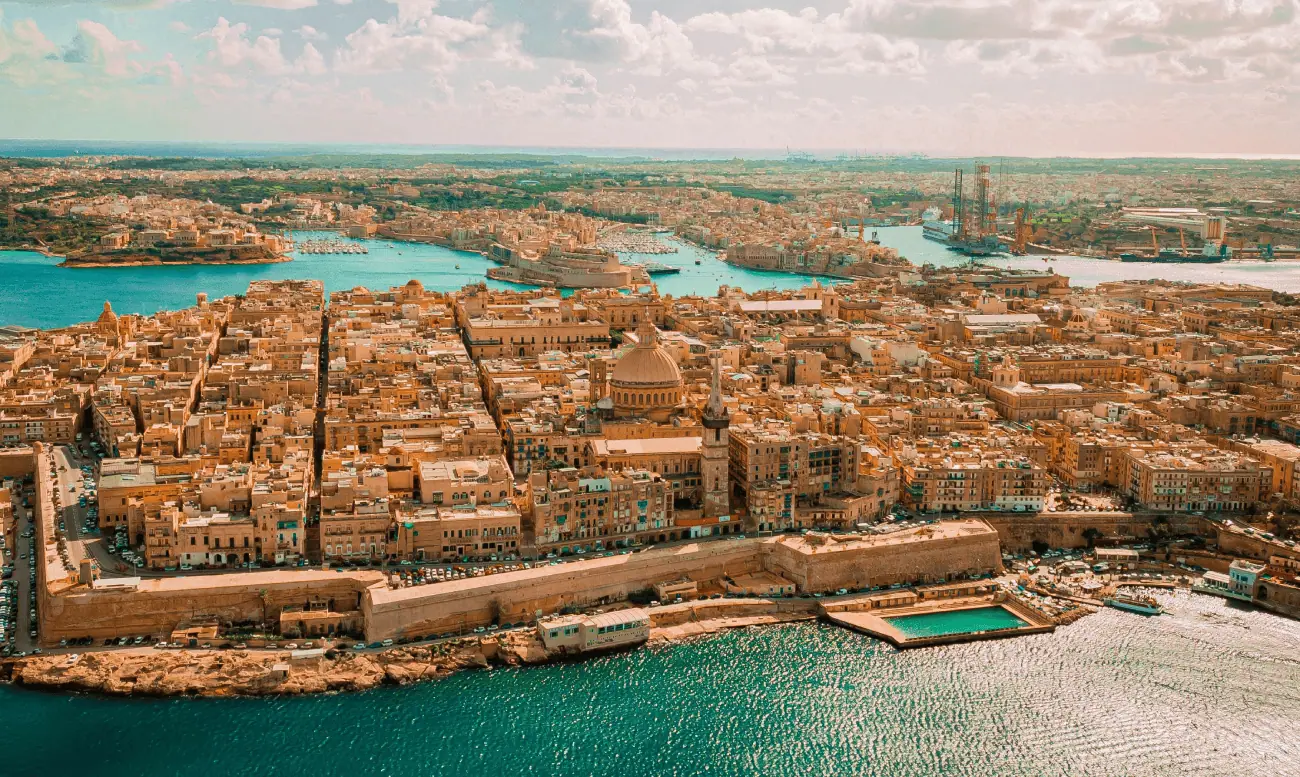
An Aerial shot of Valletta, with the Three Cities in the background (credits: viewingmalta.com)
A short boat ferry away from Valletta are the modern urban centers of St. Julian’s, Gzira, and Sliema, bringing a different energy to Malta’s landscape. St. Julian’s is famous for its nightlife, while Gzira and Sliema feature bustling promenades, superb dining options, shopping hubs, and stunning views of Valletta across the water, blending contemporary lifestyles with historic charm.
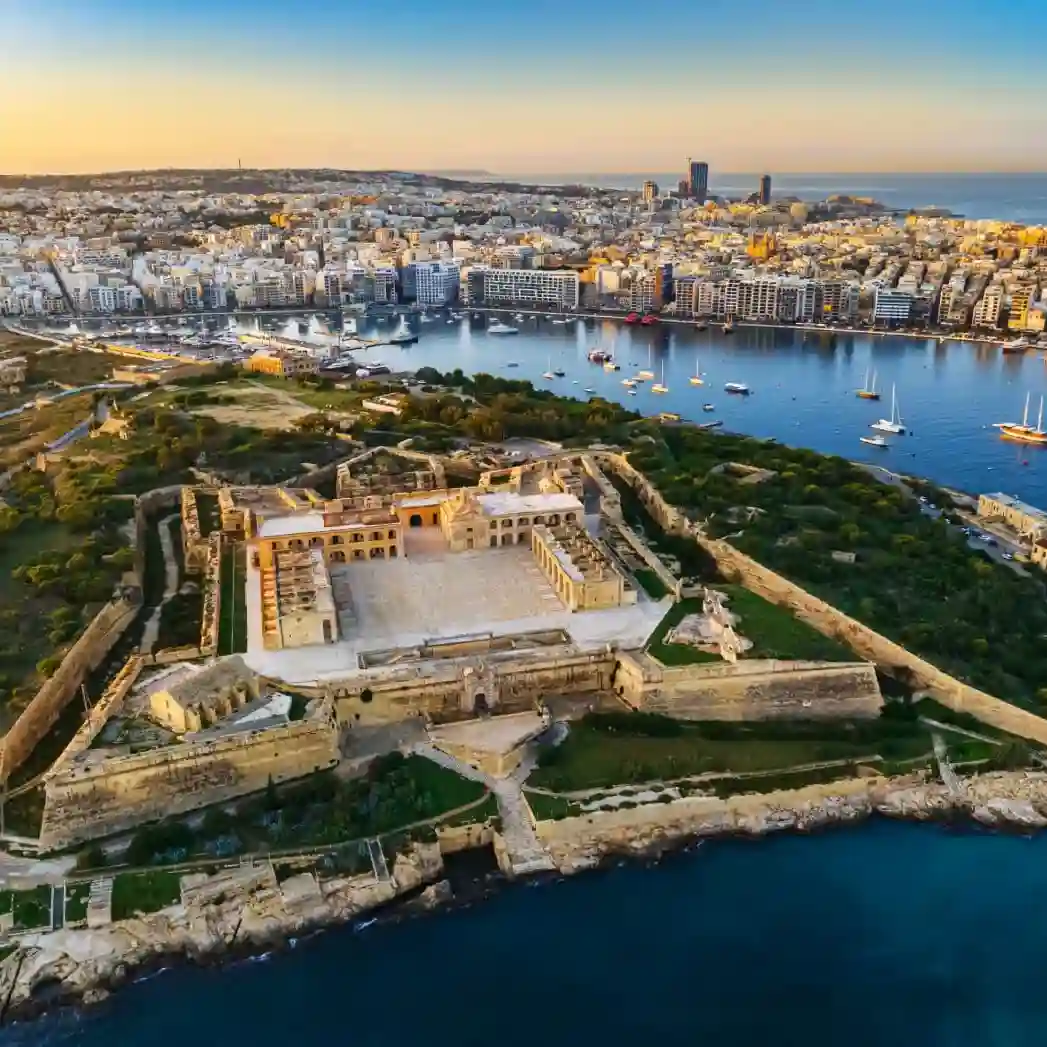
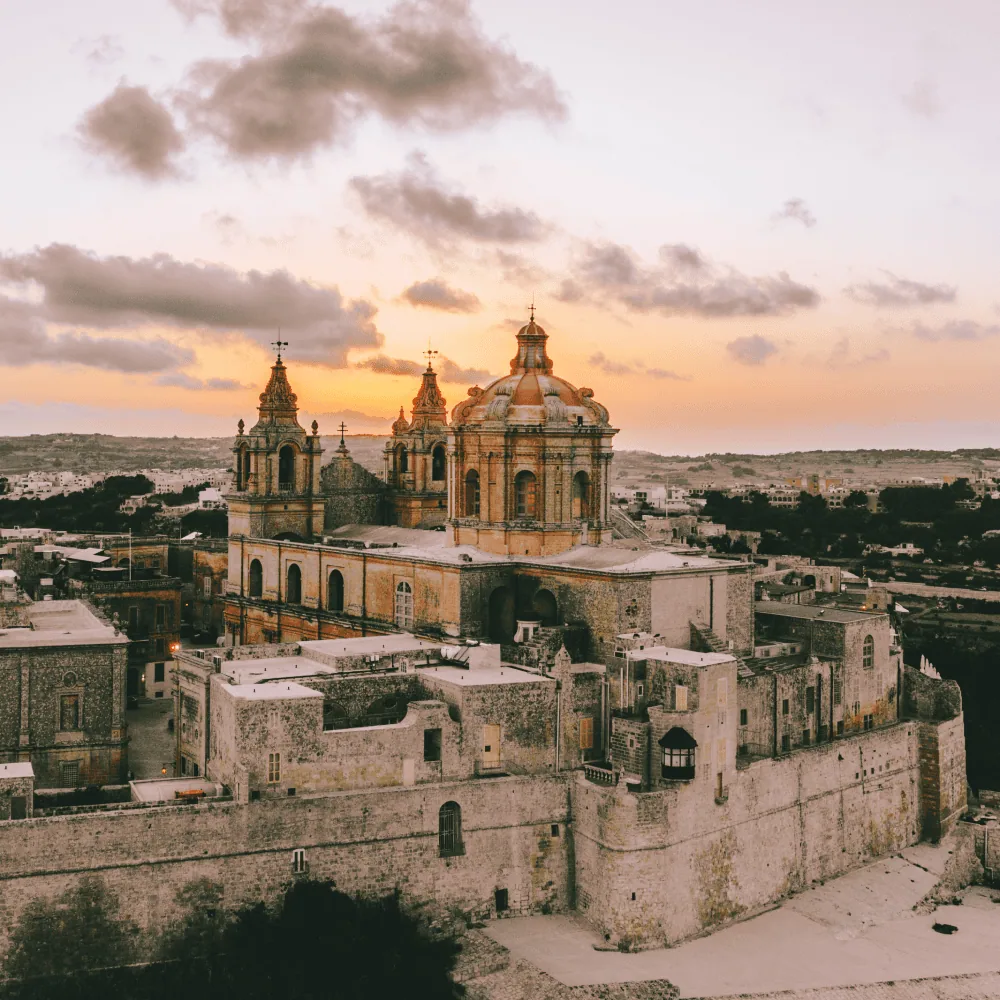
Left – The Gzira-Sliema promenade & Manoel Island. Right – Mdina (credits: viewingmalta.com)
Moving south, the picturesque fishing village of Marsaxlokk provides a more laid-back atmosphere with its iconic luzzu boats and lively markets, offering a taste of Malta’s authentic coastal life.
On the western side of the island, Malta’s rural heartland reveals itself in places like Dingli and Mdina. The Dingli Cliffs provide breathtaking views from the island’s highest points, perfect for hikers and nature lovers. Nearby, Mdina, known as the “Silent City,” is a beautiful medieval town. Perched atop a hill and surrounded by ancient walls, the old capital offers panoramic views and a serene, timeless atmosphere.
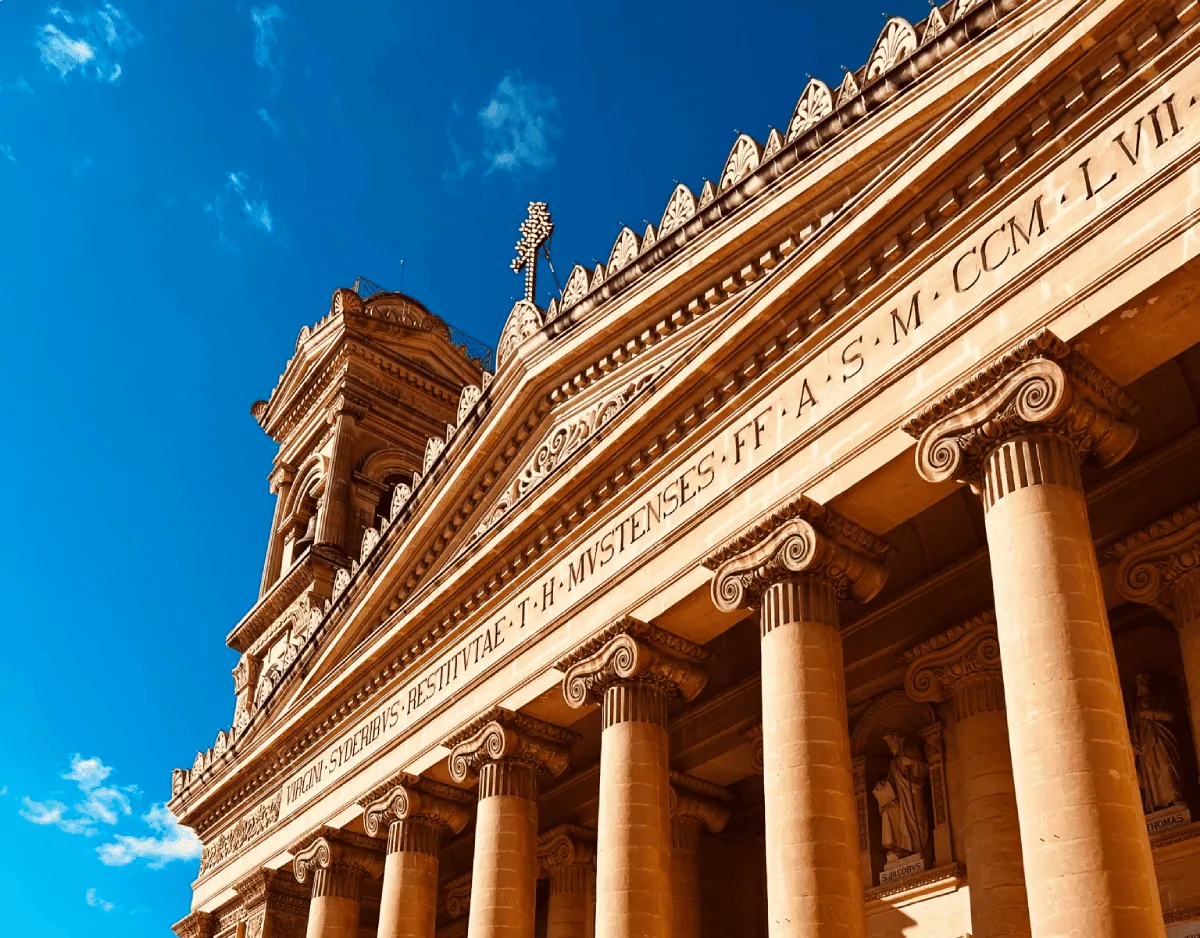
The Mosta Rotunda (credits: viewingmalta.com)
The central region of Malta is marked by the residential towns of Mosta, Attard, and Naxxar. Mosta is famous for the Mosta Dome (above), one of the largest unsupported domes in the world. Attard is known for historical sites like San Anton Palace. Naxxar, with its grand palaces and narrow streets, offers a glimpse into traditional Maltese life and architecture.
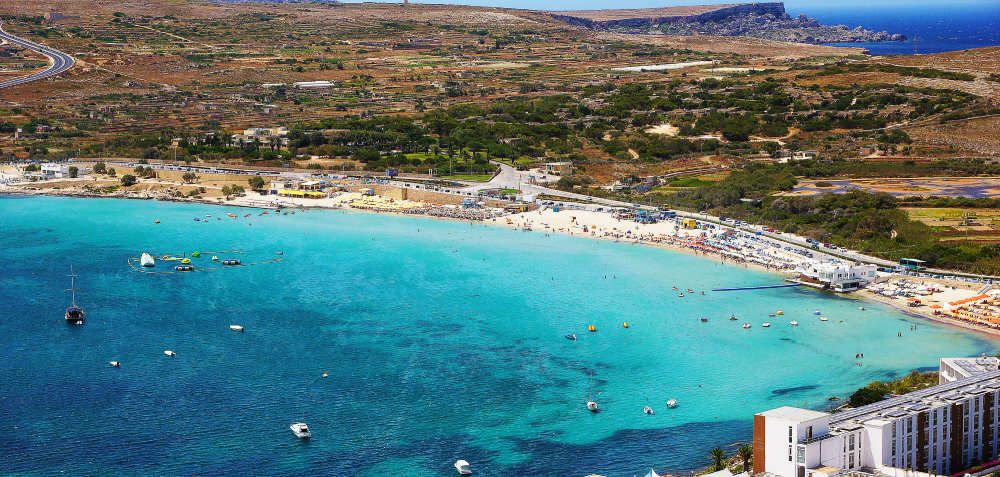
Mellieha Bay (credits: viewingmalta.com)
Heading north, Mellieha stands out with its stunning beaches, such as Mellieha Bay, Malta’s largest sandy beach, and its panoramic views from the hilltop church, making it a popular spot for both relaxation and adventure.
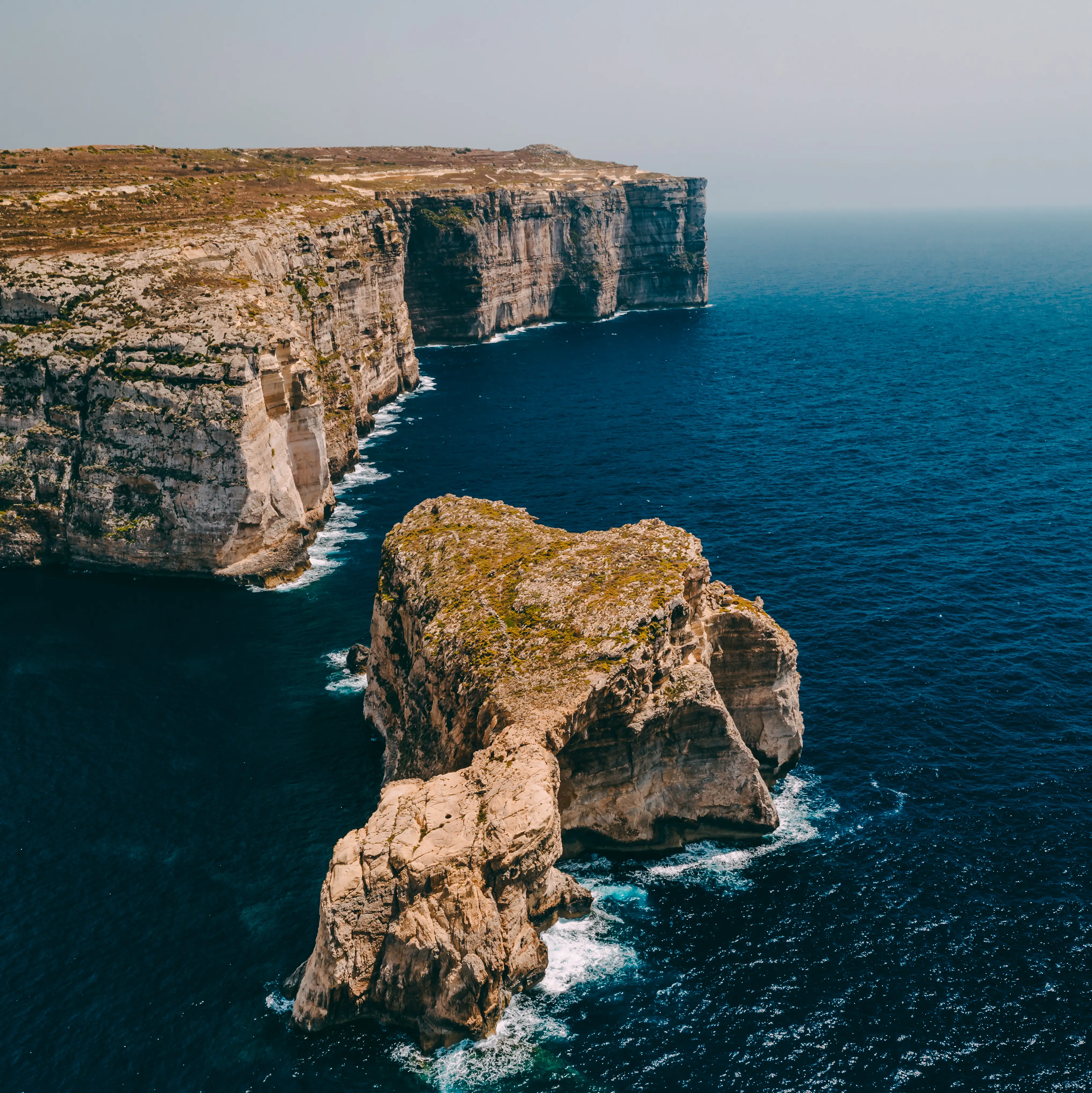
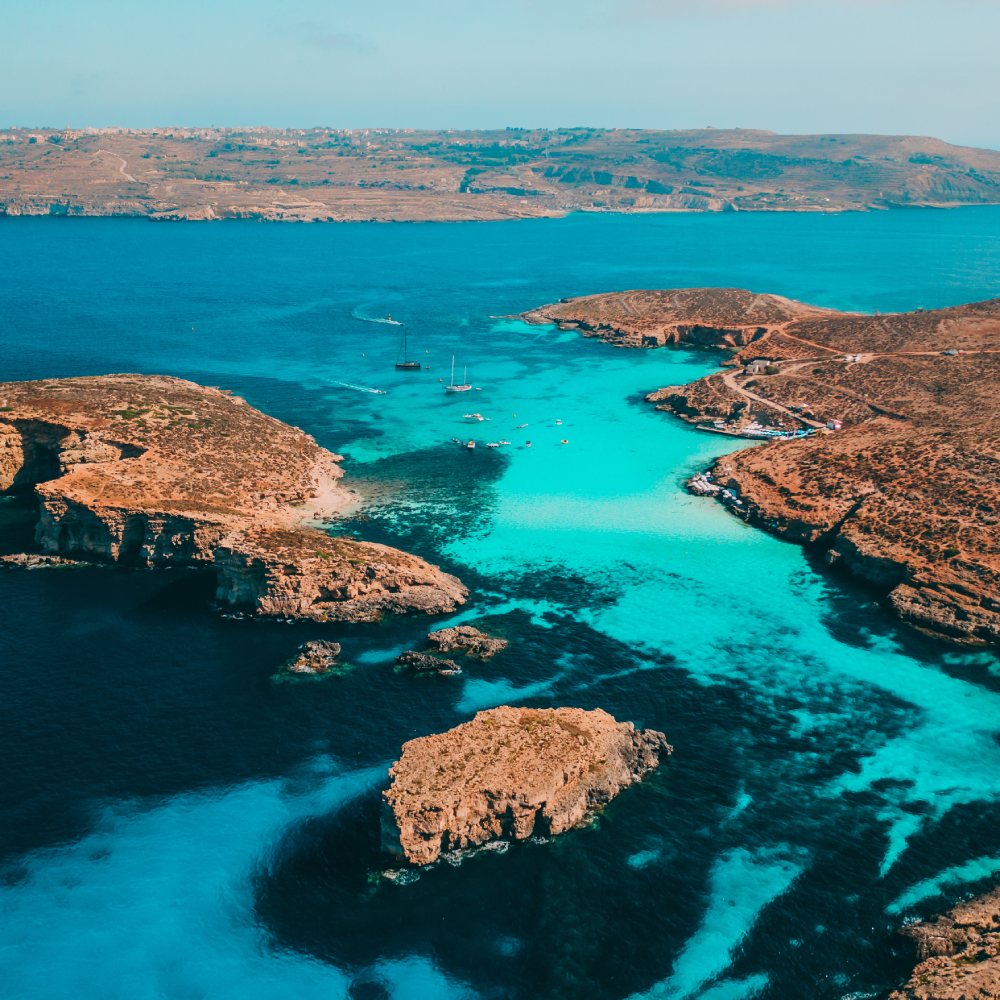
Left – The natural Gozitan landscape & Fungus Rock. Right – Blue Lagoon (credits: viewingmalta.com)
Across the channel, the island of Gozo offers a quieter, rural escape with rolling hills, timeless villages, and dramatic coastal scenery. Gozo’s capital, Victoria, features the ancient Citadel and vibrant markets, while the island’s coastline is dotted with hidden coves and dive sites that attract nature lovers and explorers. And let’s not forget Comino, the smallest of the three islands, known for the Blue Lagoon—a natural swimming pool of crystal-clear turquoise waters perfect for a day of swimming, snorkeling, and soaking up the sun.
Through the Ages
Malta’s history spans several distinct periods, each marked by significant events that have shaped its culture, architecture, and identity. Here is an overview of the key periods of Malta’s history.
From Prehistory to Arab Rule
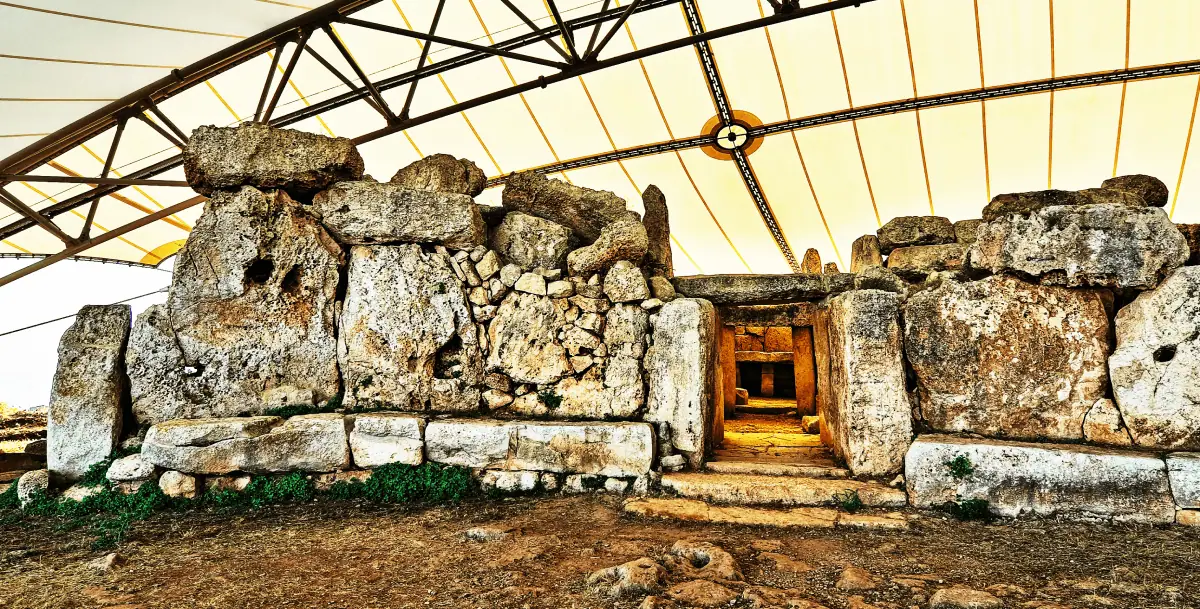
The Mnajdra Megalithic Temples (credits: viewingmalta.com)
Prehistoric Period (c. 5200 – 700 BCE). Malta’s history begins with the arrival of the first Neolithic settlers around 5200 BCE. The islands are home to some of the world’s oldest free-standing structures, including the UNESCO World Heritage-listed Megalithic Temples, such as Ħaġar Qim, Mnajdra, and Ggantija. This period is characterized by remarkable prehistoric architecture, mysterious cart ruts, and unique burial practices.
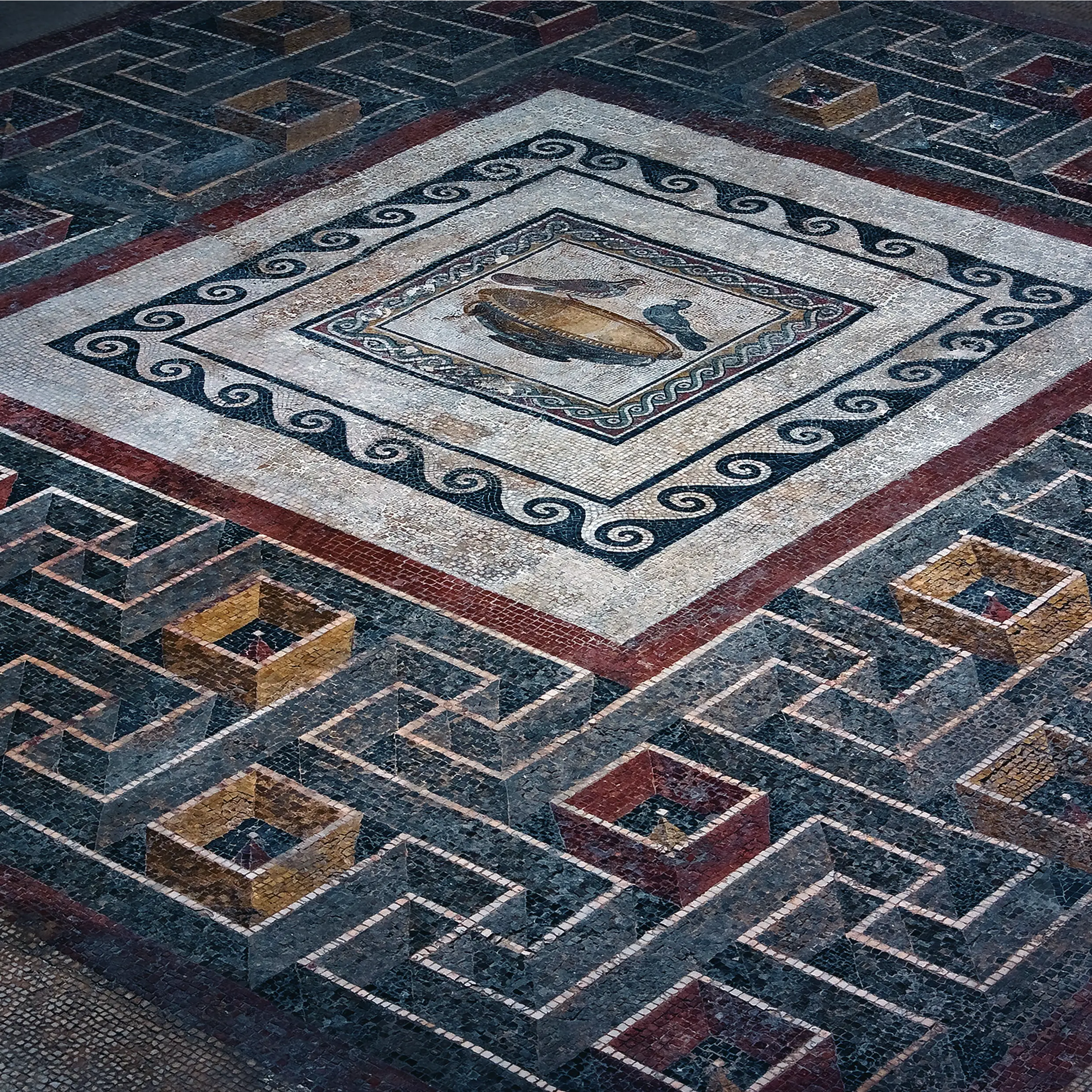
The Roman Villa mosaic in Rabat (credits: viewingmalta.com)
Phoenician and Carthaginian Period (c. 700 – 218 BCE). Around 700 BCE, the Phoenicians arrived and established Malta as a strategic trading post. They were followed by the Carthaginians, who ruled the islands for several centuries. During this period, Malta became an important hub in the Mediterranean for trade and cultural exchange.
Roman Period (218 BCE – 395 CE). Malta became part of the Roman Empire after the Second Punic War in 218 BCE. The islands flourished under Roman rule, with the city of Melite (modern-day Mdina) becoming a significant urban center. Evidence of Roman influence includes villas, baths, and the introduction of Christianity to Malta, most notably with the shipwreck of Saint Paul in 60 CE.
Byzantine Period (395 – 870 CE). After the fall of the Roman Empire, Malta became part of the Byzantine Empire. This period saw the islands becoming a frontier outpost and experiencing a decline in their strategic importance. The Byzantine influence is less pronounced, with fewer remains compared to other periods.
Arab Period (870 – 1091 CE). The Aghlabids, an Arab dynasty from North Africa, took control of Malta in 870 CE. The Arab period brought significant changes, including new agricultural practices, fortified towns, and the introduction of the Maltese language, which developed from a mix of Arabic and other influences. This era laid the foundation for much of Malta’s linguistic identity.
From The Normans To The French
Norman and Medieval Period (1091 – 1530 CE). In 1091, the Normans, under Count Roger I of Sicily, conquered Malta, marking the beginning of the island’s Latinization and firm integration into the Christian world. Over the following centuries, Malta was ruled by various feudal lords, including the Swabians, Aragonese, and Angevins. During this time, Malta became part of the Kingdom of Sicily and saw the strengthening of its fortifications and Roman Catholic identity.
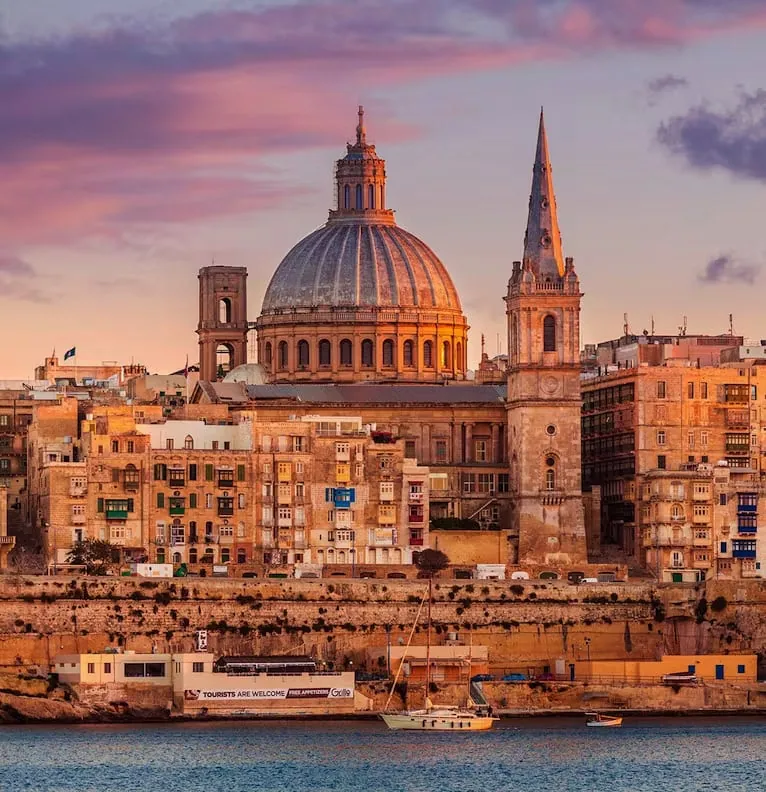
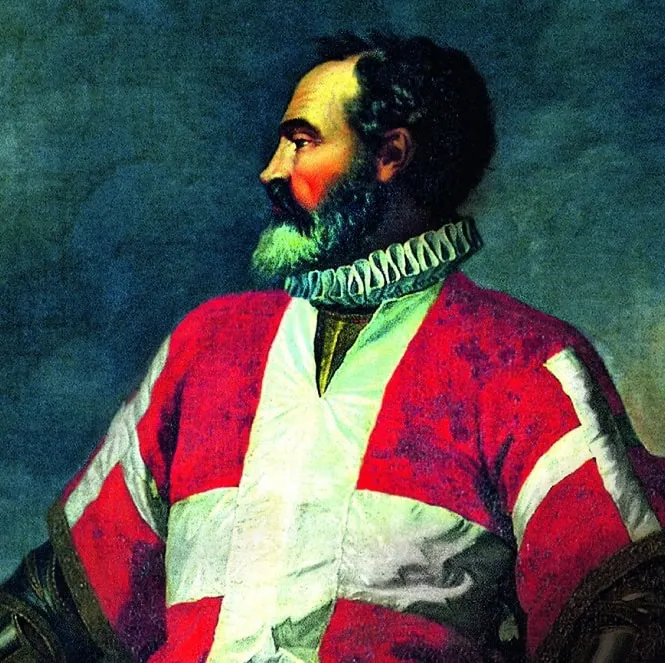
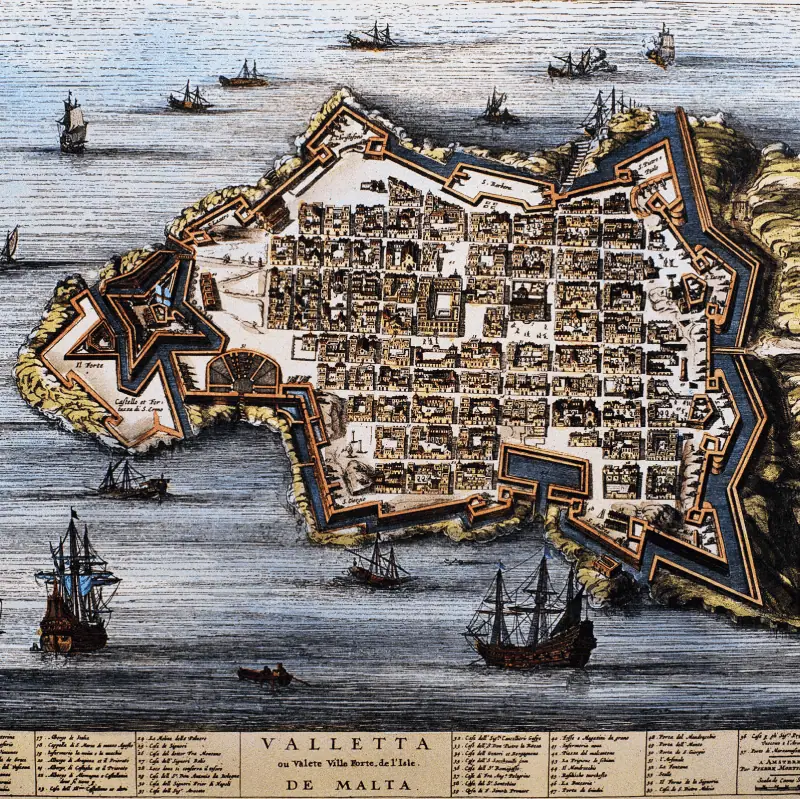
Left – The Valletta Skyline. Top Right – Jean Parisot de Valette. Bottom Right – An early Map of Valletta (credits: viewingmalta.com)
Knights of St. John Period (1530 – 1798 CE). The Knights Hospitaller, also known as the Knights of St. John, were given Malta by Emperor Charles V in 1530. This period is one of the most significant in Maltese history, as the Knights transformed Malta into a fortress island. Their greatest legacy is the defense of Malta during the Great Siege of 1565 against the Ottoman Empire and the subsequent construction of the new capital, Valletta. The Knights’ rule brought prosperity, impressive architecture, and art to the islands.
French Period (1798 – 1800 CE). In 1798, Napoleon Bonaparte’s forces captured Malta from the Knights of St. John in a mostly bloodless surrender. The French period was short-lived but impactful, as the Maltese revolted against French rule due to their policies on the Catholic Church and local resources. With the help of the British, the Maltese managed to oust the French in 1800.
From The British To Modern Day
British Period (1800 – 1964 CE): Malta became a British protectorate in 1800 and a Crown Colony in 1813. Under British rule, Malta underwent profound changes that shaped its modern identity. Strategically crucial in World War II, Malta was one of the most heavily bombed places on Earth. The Maltese people’s resilience throughout severe hardship earned them the George Cross from King George VI, a symbol of their bravery that still appears on Malta’s flag today.
The British significantly impacted Malta’s language, culture, and institutions. English became an official language alongside Maltese, transforming education, legal framework, government, and commerce and creating a unique bilingual society. Culturally, British influences mingled with Maltese traditions, from architecture to cuisine.
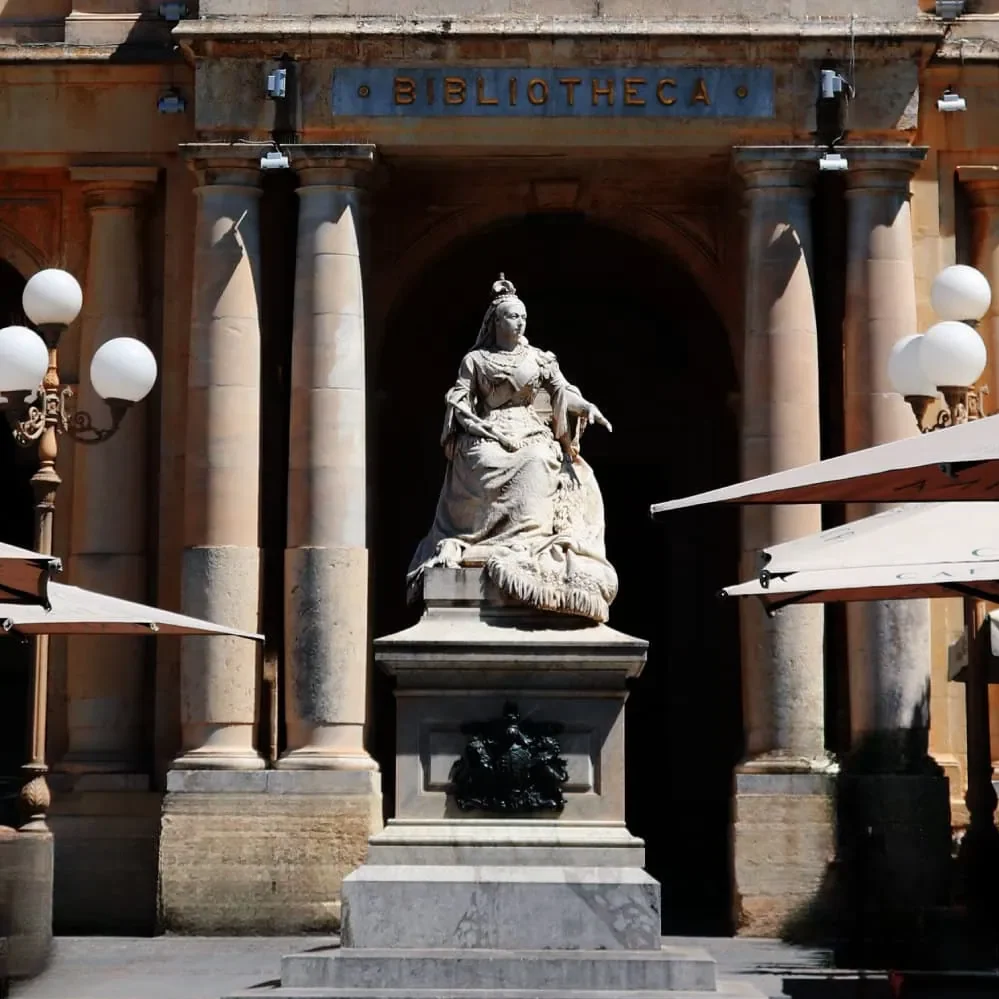
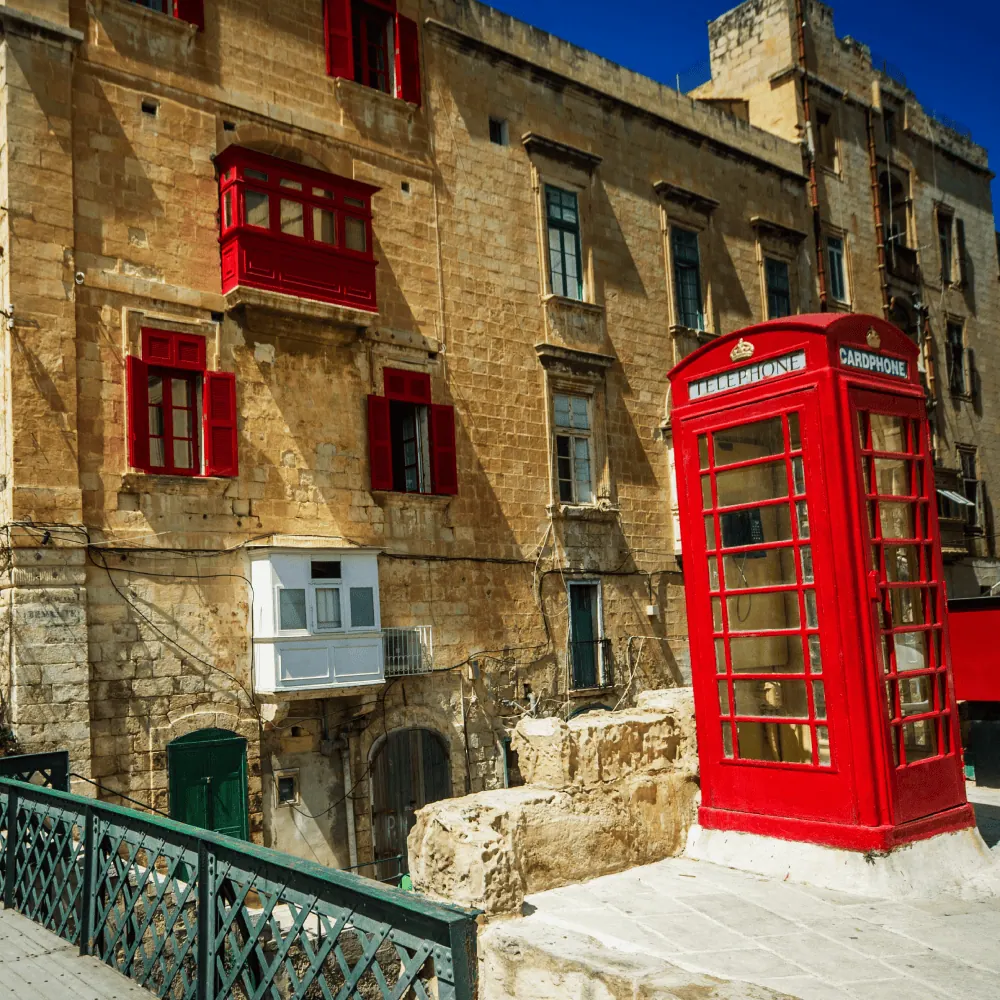
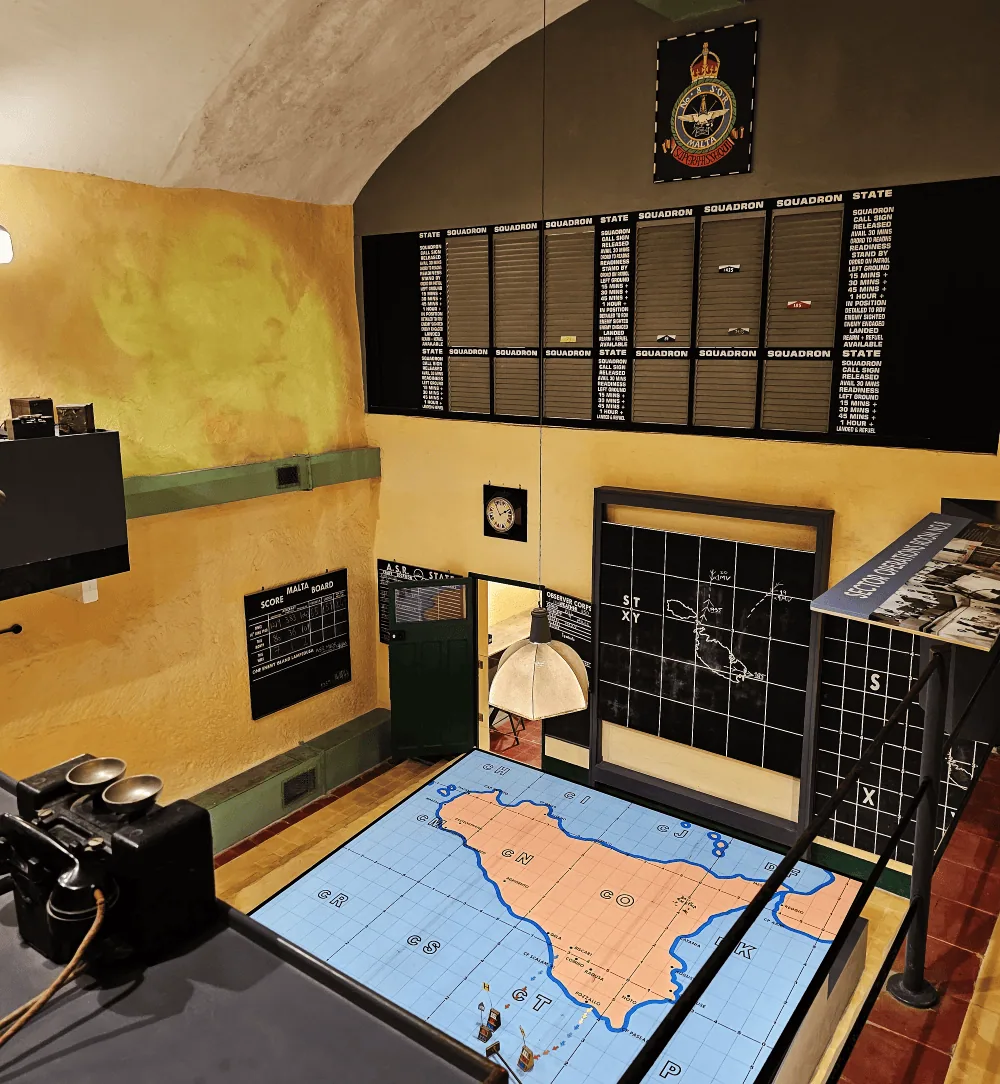
Top Left – A monument dedicated to Queen Victoria in front of the national library. Bottom Left – A British telephone box in Valletta. Right – The Lascaris War Rooms (credits: viewingmalta.com)
Independence and Modern Period (1964 – Present). Malta gained independence from Britain on September 21, 1964, navigating its path as a sovereign nation. In 1974, Malta became a republic, with the British monarch replaced by a Maltese president as head of state. The departure of British military bases in 1979 marked full political and military independence.
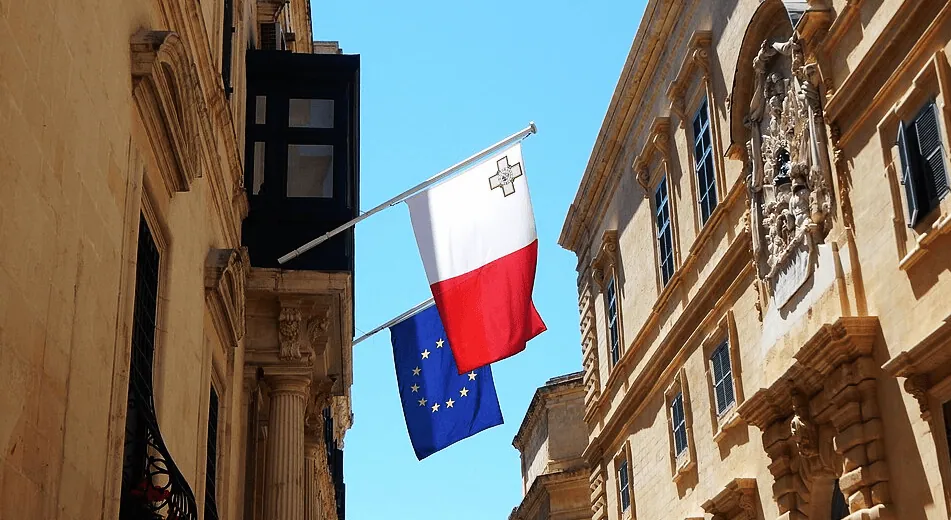
Over the following decades, Malta focused its efforts on economic diversification. It developed industries like tourism, manufacturing, and financial services. In 2004, Malta took a historic step by joining the European Union, aligning itself with European economic and political systems. The adoption of the Euro followed in 2008. Today, Malta is a thriving EU member state known for its robust economy, strategic Mediterranean location, and unique cultural blend. It continues to balance tradition with modernity, serving as a bridge between cultures and as a dynamic hub for business, tourism, and international diplomacy.
Experience Our Identity
Malta’s cultural identity is a tapestry woven from its rich and diverse history. It is shaped by centuries of influence from various civilizations that have left their mark on these islands. The country’s deep-rooted Roman Catholic faith has also left its mark. This cultural diversity is evident in Malta’s language, cuisine, architecture, traditions, and festivals, offering visitors a fascinating journey into its past and present.
The Language
The Maltese language, Il-Lingwa Maltija, is a testament to its complex history. As the only Semitic language written in Latin script, Maltese reflects a unique blend of influences. Its roots trace back to Siculo-Arabic, an ancient dialect spoken in Sicily and Malta during Arab rule. Maltese has since absorbed elements from Italian, English, and French, making the language a living example of Malta’s past as a cultural crossroads. Today, Maltese is the national language and one of the official languages of the European Union, alongside English. It is widely spoken across the islands and serves as a powerful symbol of national pride and identity.
Have a listen to the above video for a taste of the Maltese language. If you plan to visit the islands, this video can also serve as an opportunity to grab a few basics to use during your trip. You won’t need it, but why miss an opportunity to impress us locals?!
The Cuisine
Maltese cuisine is another expression of its identity, reflecting a blend of Mediterranean flavors with influences from Italian, Arabic, and regional cuisines.
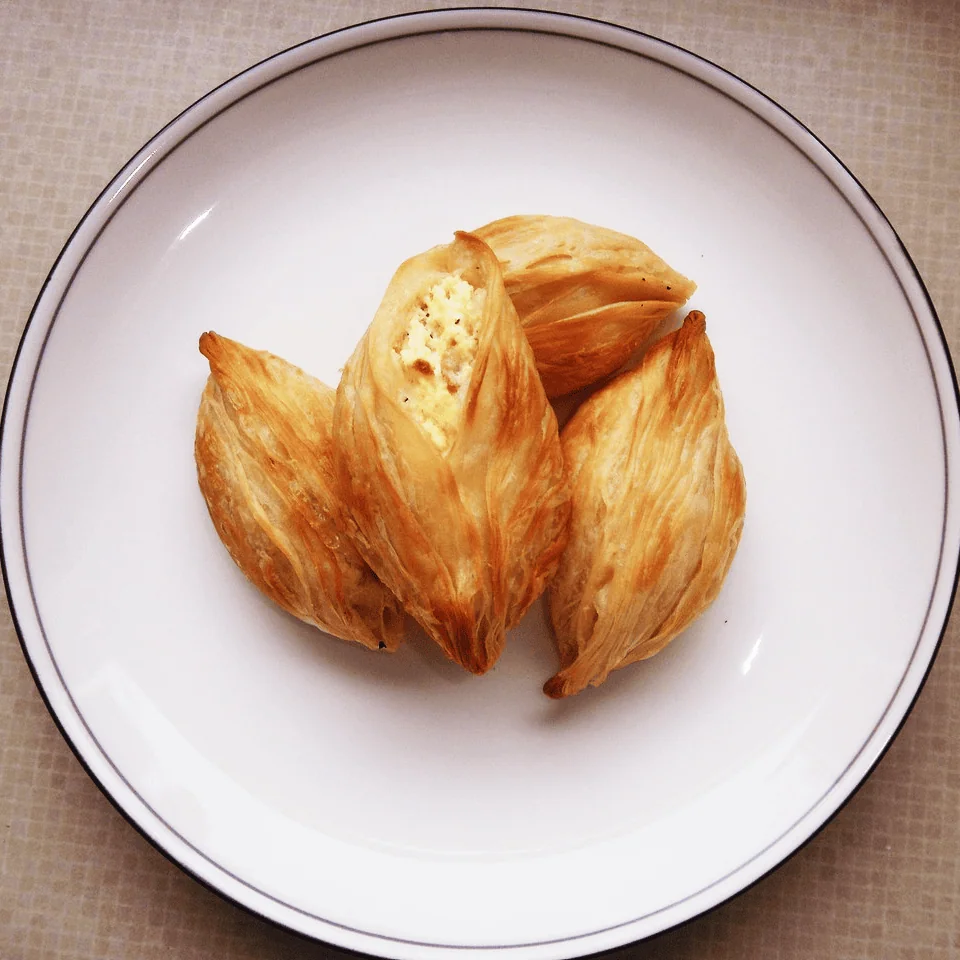
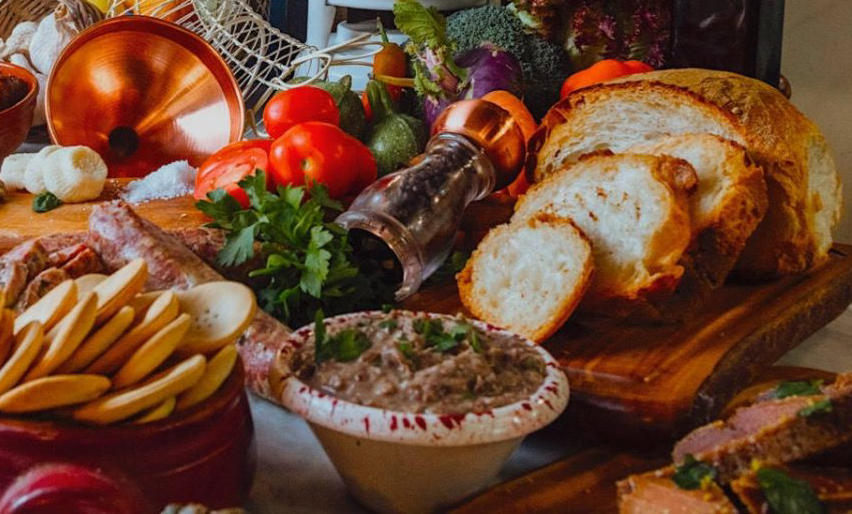
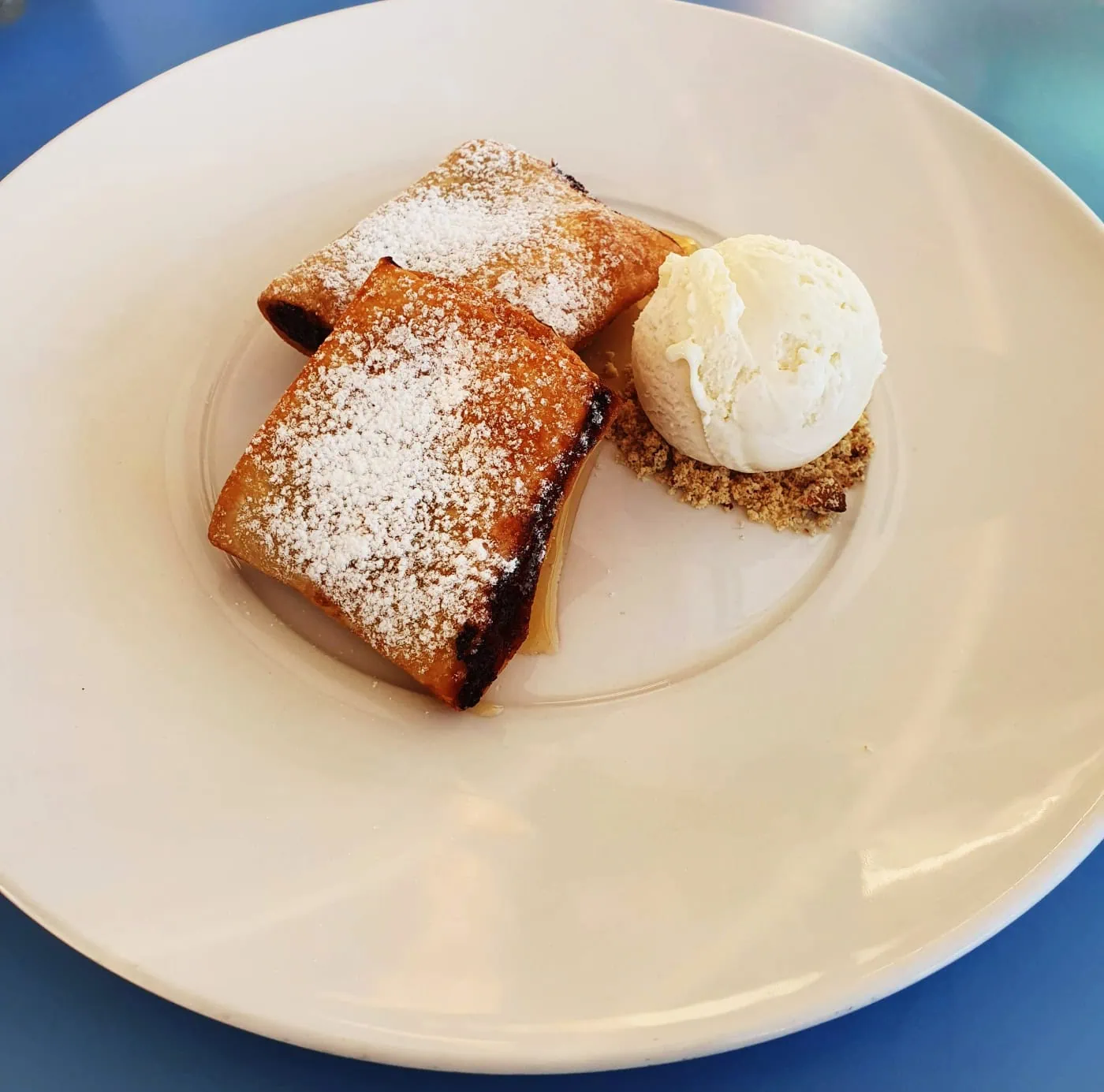
Left – Pastizzi. Centre – Maltese bread, bigilla, galletti, gbejniet, Maltese sausage. Right – Imqaret (credits: viewingmalta.com)
Among the most beloved street foods are pastizzi, flaky pastries filled with ricotta cheese or mushy peas, offering a quick and delicious taste of local life. Maltese bread, or Ħobż tal-Malti, is another staple, a sourdough bread known for its crusty exterior and soft interior. Other popular dishes include rabbit stew (fenek), kapunata (the Maltese version of ratatouille), and lampuki pie, to name a few. Imqaret – fried pastry pockets filled with dates and flavored with aniseed and orange zest – are one of the country’s most popular desserts. True to its Mediterranean roots, Maltese cuisine emphasises fresh, local ingredients.
Festivities & Traditions
Festivities and traditions are at the core of Maltese culture. At the heart of Maltese celebrations are the festas, recognised as an intangible cultural heritage of humanity by UNESCO. Often held during the Summer months, most villages hold a feast as an expression of culture and devotion to the village patron saint. Events are marked by colorful processions, marching bands, fireworks, and street parties, creating a lively and communal atmosphere.
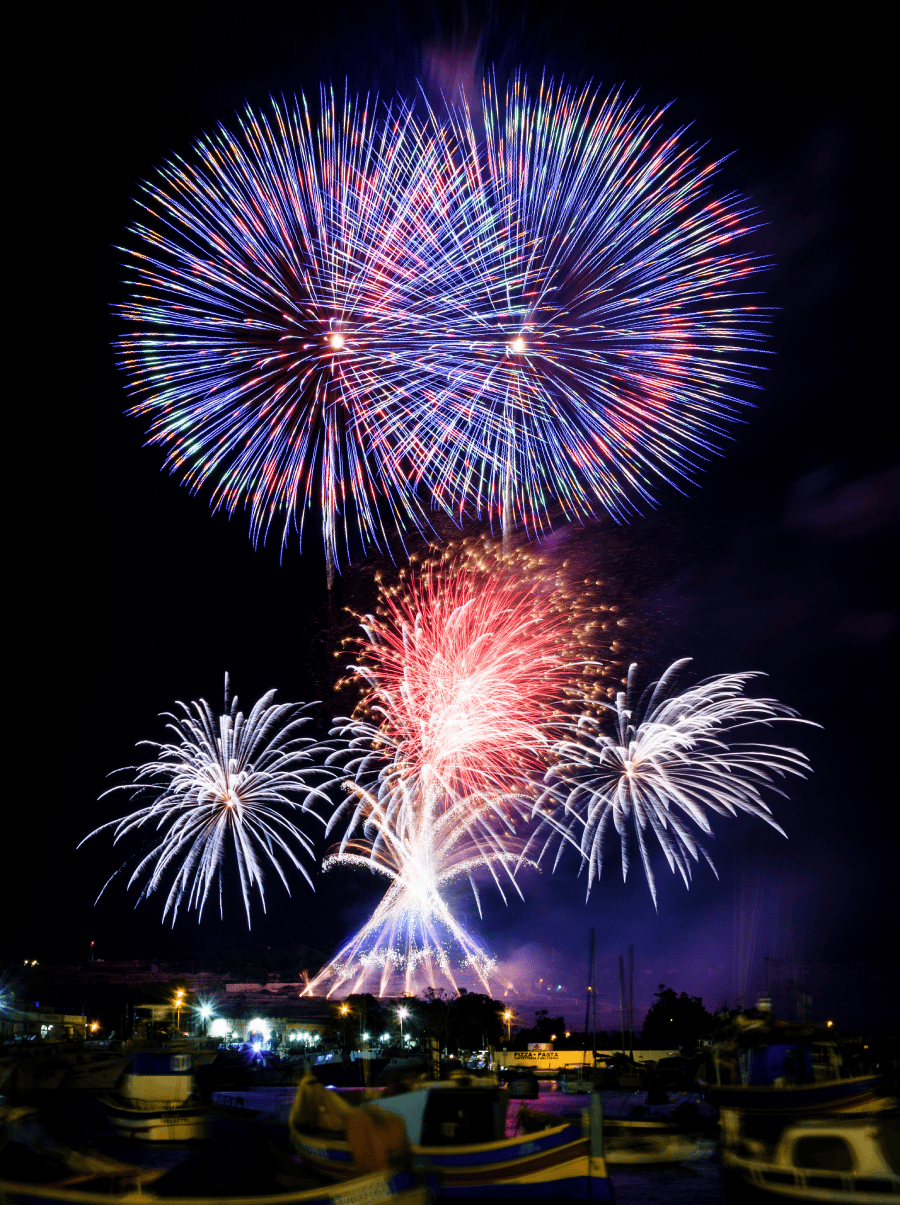
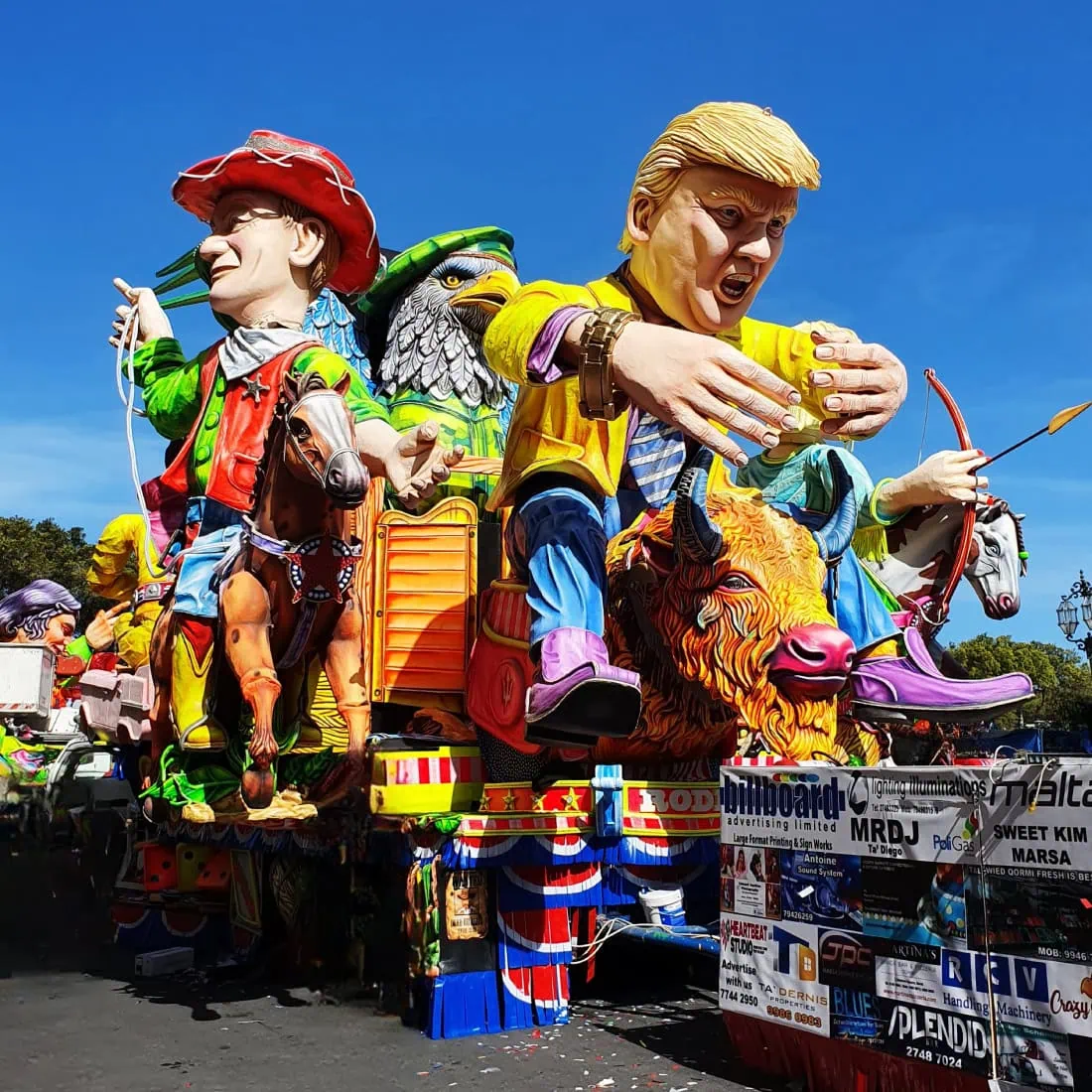
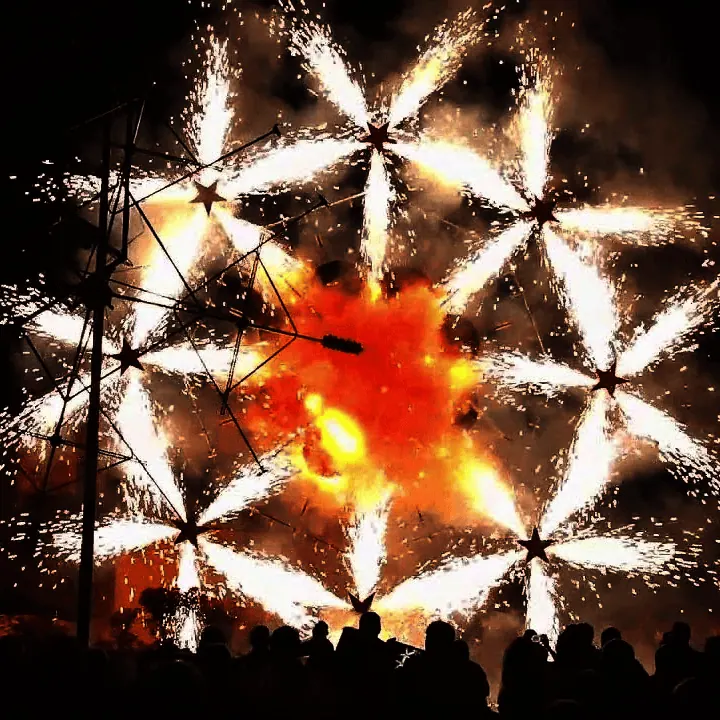
Left – Fireworks during a Maltese festa. Top Right – A carnival float paraded in Valletta. Bottom Right – Ground fireworks during a Maltese festa.
(credits: viewingmalta.com)
Another cherished tradition is the Maltese Carnival, a centuries-old celebration filled with elaborate costumes, music, and dance. Carnival floats are a form of public satire, with local and foreign figures often the target of such creativity. Beyond these large-scale festivities, Malta also observes seasonal traditions like Easter parades and Christmas presepju (nativity scenes). Together, these festivities embody the warmth, joy, and communal spirit of Maltese culture, showing the island’s ability to blend religious significance with a festive Mediterranean flair.
Art, Architecture & Symbolism
Maltese art and architecture are rooted in centuries-old history and religious traditions. This is evident in the country’s baroque churches, adorned with Renaissance paintings, gilded interiors, and detailed sculptures. Historic buildings and fortifications, such as the Grandmaster’s Palace and the Valletta bastions, tell a story of Malta’s eventful past.
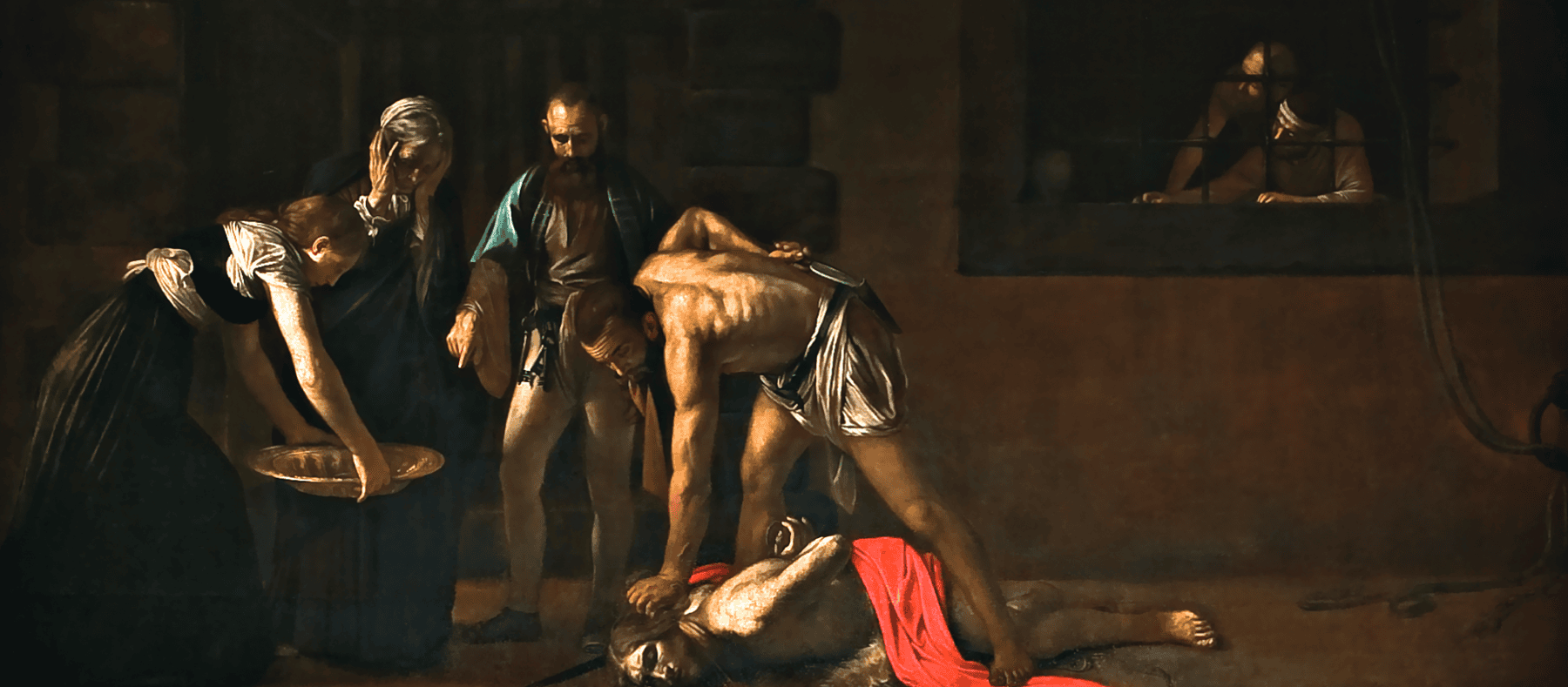
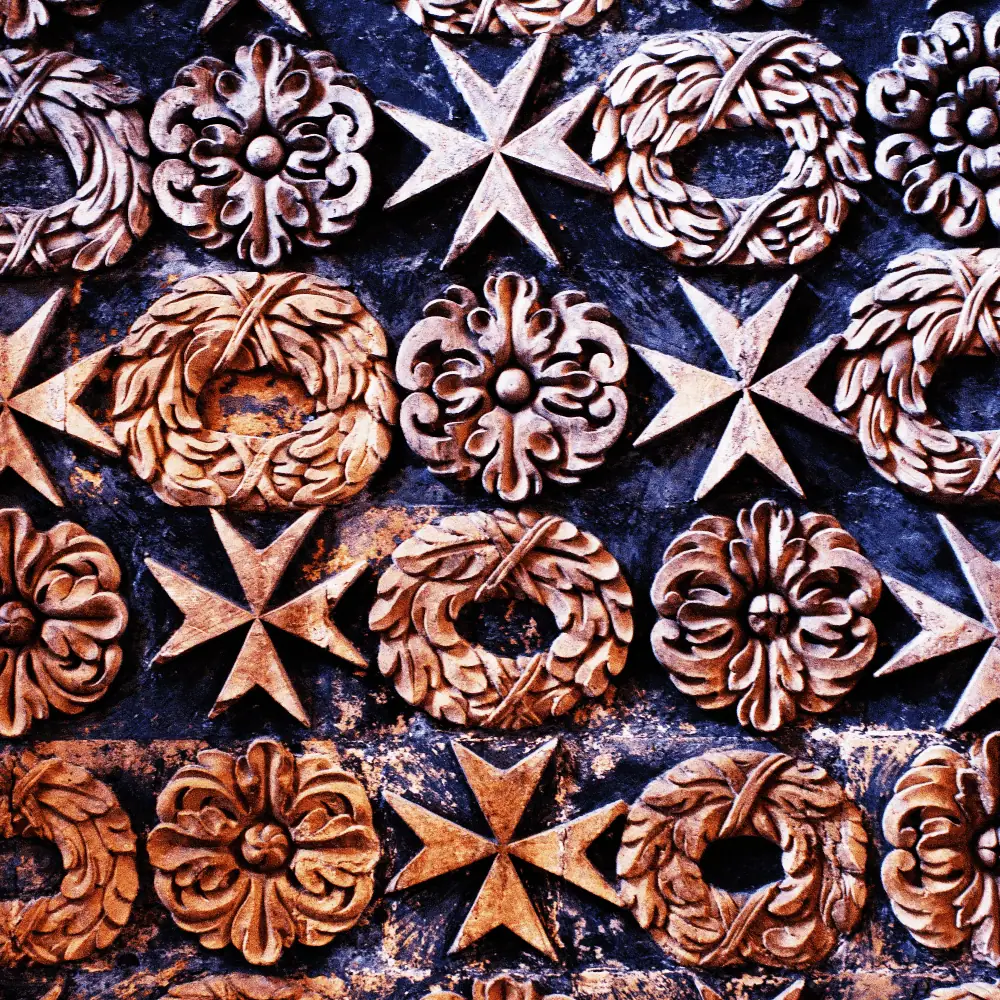
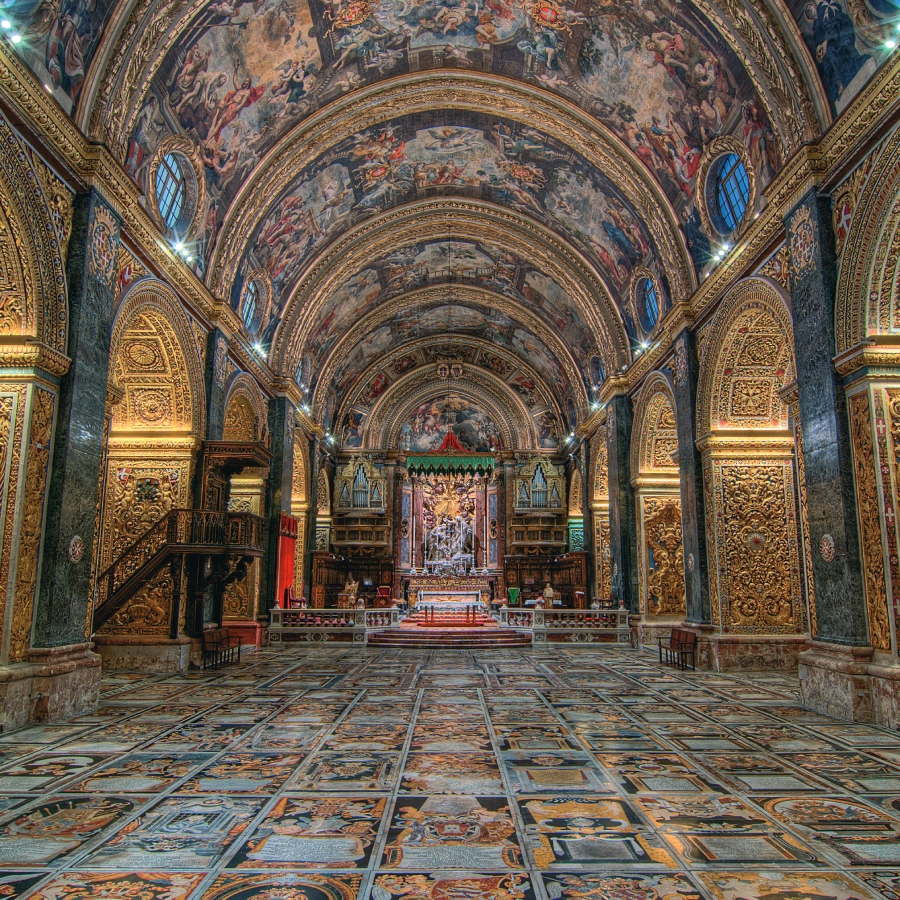
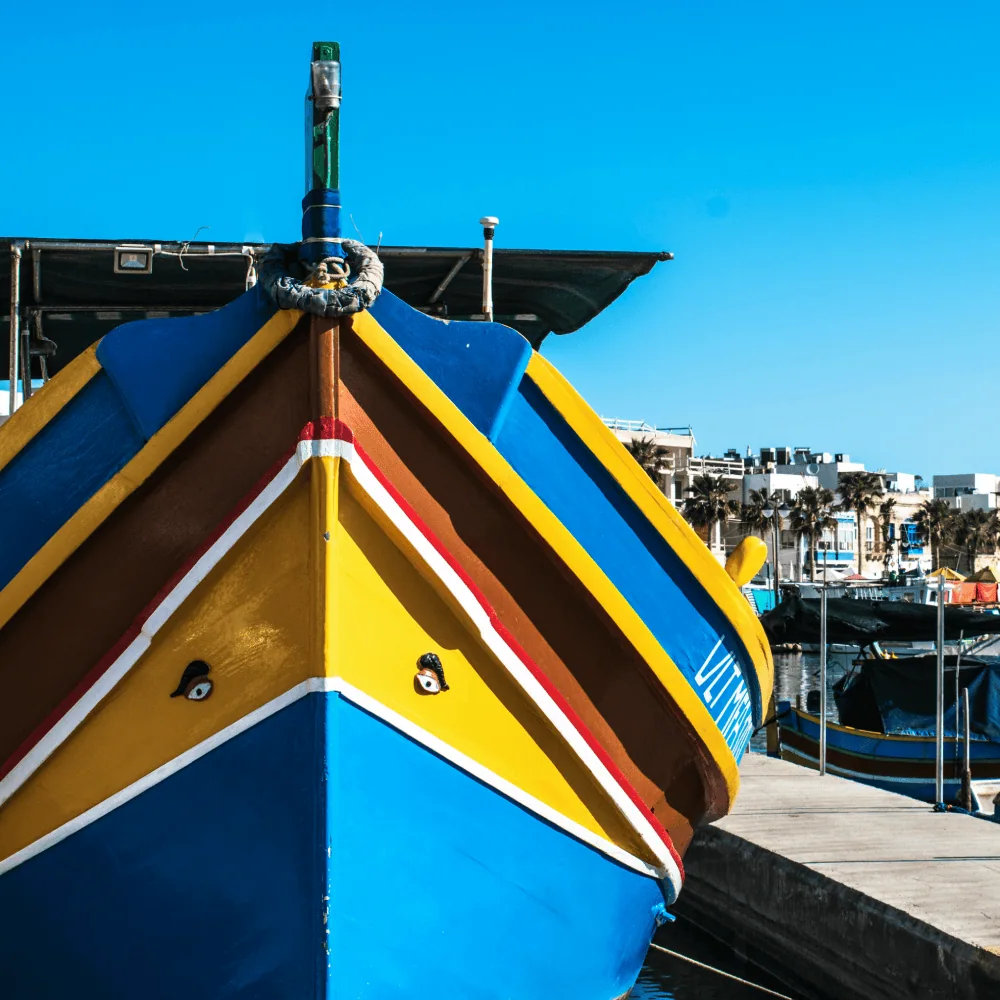
Top – The beheading of St John, a famous painting found in St John’s Cathedral. Bottom Left – A mural containing the eight-pointed Maltese cross. Bottom Centre- An internal shot of St John’s Cathedral. Bottom Right- The traditional luzzu (credits: viewingmalta.com)
The Maltese Cross, inherited from the knights, symbolizes the island’s history of resilience, faith, and the values of chivalry. Beyond its grand architecture, everyday life in Malta also carries symbolic meaning. The traditional luzzu boats, painted in bright colors with eyes on their bows, reflect Malta’s Phoenician heritage, which is believed to ward off evil spirits and protect fishermen. The limestone buildings with their distinctive gallarija (enclosed wooden balconies) further add to the unique Maltese streetscape, blending practical design and elegance. There is a bit of culture around every corner in Malta, you just need to know where to look!
Life As A Local
Life as a local in Malta is a mix of tradition and community spirit. While our lifestyle has been getting more hectic for the sake of progress, we also know how to love life, and seek ways to enjoy our Mediterranean heritage. Growing up in Malta leaves a strong sense of family and friendship that binds us. Whether it’s a big Sunday lunch with relatives or a quick chat with neighbors at the local pastizzeria, there’s always a feeling of warmth and connection. Our villages are lively affairs, with our elderly gathering around the piazza for coffee, followed by a quick stop by the church.
We cherish our time spent at the sea, whether it’s a summer swim at a quiet rocky bay or a sunset stroll along the Gzira-Sliema promenade. Being a small island, our friends and relatives are never too far, and often seek to meet in our homes, at local cafes or for a bite at one of our many venues. We love to share stories, laugh, and debate (argue?), often in a mix of Maltese and English. Both languages are part of who we are, as does our often vibrant use of language.
Festivities are a big part of life here. Our festas, celebrated in every village, are more than religious events—they’re a celebration of community. The whole village transforms with marching bands, vibrant decorations, fireworks, and food stalls lining the streets. We also look forward to Carnival, Easter processions, and Christmas celebrations that fill our calendars with color and joy throughout the year.
Speaking of community, us Maltese are known for our warmth and hospitality, rooted in our community values and pride for our heritage. We are eager to share stories, offer recommendations, and help with a friendly smile. In true Mediterranean spirit, we can often be loud and a bit temperamental, so please forgive us we if we sometimes come across as a handful! We promise that it’s coming from a good place.
Food is another huge part of our identity. Pastizzi are our guilty pleasure, and Maltese bread tastes like home. We eagerly await seasonal produce including Lampuki in late Summer and strawberries in early Spring. On Sundays, we often gather for long lunches featuring fenek (rabbit stew) – a national favorite – or freshly caught fish grilled with local herbs and olive oil.
Despite our small size, we are proud of our island’s mix of history and modern life. We walk among ancient buildings and fortifications that tell stories, yet we enjoy a growing, modern society that’s part of the European Union. Living here means balancing these contrasts daily—old and new, quiet and lively, traditional and modern. For us Maltese, this is not just a way of life, but a reflection of who we are and where we come from.
It is no surprise that Malta is becoming an increasingly popular tourist destination. The country also enjoys a healthy expat community, driven both by the economy, as well as by those seeking the lifestyle described above. While this starter guide to Malta’s heritage is nearing its end, have a look at our travel. culture or experiences articles if the above sounds interesting to you. On second thoughts, why not grab a stay at one of our accommodations?
Related Content
Before you go, check out the links below if you’re eager for more details and insider tips.


